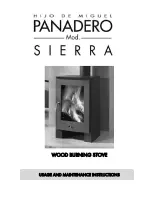
REFUELLING
To achieve the nominal output the product would
need to be refuelled at 45 minute intervals with a fuel
load of approximately 1.9kg. Do not overfill the com-
bustion chamber, ensure that all logs are retained in
the fire using by the fire fence. Reduced outputs will
result when fuels of lower calorific values are used.
Following refuelling open the ash door slightly until a
flame is established for best combustion of the
wood.
DE-ASHING & DISPOSAL
De-Ashing must be carried out when the stove is
cold.
Brush the ashes through the grate into the
ashpan below.
The ashpan should be emptied every day.
If ashes are allowed to build to grate level you could
damage the firebars by overheating.
Ashes should be placed in a metal or other non-
combustible container with a tight fitting lid. The
closed container of ashes should be placed on a
non-combustible material, pending final disposal. If
ashes are buried in soil, or otherwise dumped they
should be retained in the closed container until they
are thoroughly cooled. See Fig.21.
Fig.21
soot door to clean the collection point. To clean the
top of the stove the hotplate can be removed. To
remove the hotplate apply some downward pressure
and twist it in a clockwise direction. Clean out the
stove thoroughly and replace the hotplate ensuring
a proper seal is achieved.
NOTE:
Where the chimney is believed to have
served an open fire installation it is possible that the
higher flue gas temperature from a closed appliance
may loosen deposits that were previously firmly
adhered, with the consequent risk of flue blockage,
it is therefore recommended that the chimney be
swept a second time within a month of regular use
after installation.
FIRE SAFETY
To provide reasonable fire safety, the following
should be given serious consideration.
1. Do not over fire the stove.
2. Over-firing will also damage painted or enamel
finish.
3. Install a smoke detector in the room.
4. A conveniently located class A fire extinguisher to
contend with small fires resulting from burning
embers.
5. A practical evacuation plan.
6. A plan to deal with a chimney fire as follows:-
(a) Notify the fire department.
(b) Prepare occupants for immediate evacua-
tion.
(c) Close all openings into the stove.
(d) While awaiting the fire department watch for
ignition to adjacent combustibles from over-
heated flue pipe or from embers or sparks
from the chimney.
CHIMNEY CLEANING
The baffle assembly in this product is difficult to
remove and not recommended for chimney clean-
ing, during installation your installer should have
provided an access point in the chimney which will
allow the chimney to be brushed in both directions.
During cleaning some soot/debris will fall into the
stove and also the collection point. Remove the
15
Ashpan
Hotplate
Ashpan Lifting
Tool




































